Estimated benefits accrued due to trench method in Uttar Pradesh
This method is spreading fast in sugarcane growing areas of sub-tropics as growers can realize high input use efficiency and it provides ample scope for accommodating inter-crops between sugarcane rows. This method is ideally suitable for mechanized operation, less labour requirement, enhanced water use efficiency. Under this method of planting, farmers can obtain an average cane yield of 110 t/ha with a Cost benefit ratio of 2.15.
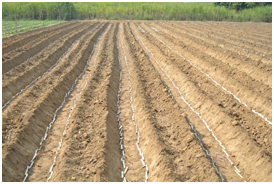
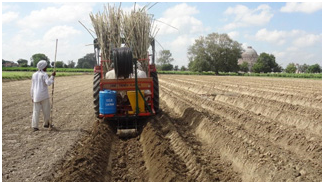
Impact analysis is based on the data available from department of U.P. Cane Commissioner Office. The total actual area of area planted during 2016-17 under 9 different zones (Saharpur, Meerut, Muradabad, Bareilly, Lucknow, Faizabad, Devipatan, Gorakhpur and Devria of UP. This method is very much suitable for planting of sugarcane as well as intercropping. Intercrop provides an additional income to grower mid season to sustain their monetary requirement instead of waiting for one year. Trench method of planting occupied an area of 41.88% of total sugarcane cultivated area in Uttar Pradesh. The approximate benefit from this technology was achieved as Rs 777.6 crore during 2015-16 to the growers. A total benefit expected to generate due to this technology will be more than 6 billion during 2017-18 in Uttar Pradesh. The detail information of analysis was presented as below:
Table. Estimated benefits of trench method of planting in UP during 2015-16
| Item | Unit |
| Total cropped area (Plant & ratoon) of sugarcane in UP | 2.16 m ha |
| Approximate total area under trench method of planting | 0.648 m ha |
| Estimated improvement in cane yield by trench method of planting | 4.0 t/ha |
| Contribution of trench method in total cane yield | 2.592 m t |
| Minimum support price of sugarcane (Rs) | Rs 3000 /t |
| Total benefits generated due to trench method technology (Rs) | 7776 million |
Table 5. Projected benefits of trench method (plant crop) in UP during 2016-17
| Item | Unit |
| Total area planting during 2016-17 (Autumn + Spring ) | 1242804.35 ha |
| Total area covered by trench method | 520523.52 ha |
| Average cane yield increased due to trench method | 4.0 t/ha |
| Total cane yield increased due to trench method of planting | 2082094 (t) |
| Total benefit generated due to trench method of planting (Rs) | 624 crore |
A success story on Trench Method of planting has also been telecast by the News Channel ABHI TAK on dated 10.06.2016. The detailed information is available through given url https://youtu.be/5q8sKJOqZ1g. The name of farmer is Sri Brahmpal who belongs to district Jaunpur. He has been awarded with Rs 7000 for the highest productivity of sugarcane as 220 t/ha through trench method of planting and a cash prize Rs 50000 by Rajya Ganana Samity of Uttarpradeh.
Table: 6 Comparative benefits of different planting methods
| Methods of planting | Cane yield (tonnes/ha) | Cost of cultivation (Rs./ha) | Net return (Rs/ha) | B:C ratio |
| Conventional furrow planting at 90 cm apart | 94.87 | 56319 | 119340 | 2.10 |
| Deep furrow (20 cm) planting at 90 cm apart covering setts with 2.5 cm of soil layer | 99.14 | 61981 | 121688 | 1.94 |
| Paired row furrow planting at 120 : 60:120 cm | 97.02 | 56657 | 123285 | 2.15 |
| Paired row deep furrow (20 cm) planting at 120: 60:120 cm covering setts with 2.5 cm of soil layer. | 101.23 | 62301 | 125354 | 1.99 |
| Modified trench planting at 120 cm apart placing setts across the furrow and covering them with 2.5 cm of soil layer | 120.18 | 68192 | 154436 | 2.23 |
| CD(P=0.05) | 4.93 | - | - | - |
Furrow irrigated raised bed system (FIRBS) method of planting:
Advantage of this technology is to minimize the yield loss due to delayed planting of sugarcane in the prevailing wheat-sugarcane system. Under this system of planting, sugarcane yield enhances by 30% and full yield of wheat as compared to sequential cropping wheat and sugarcane. Singh et al (2012) found that irrespective of the location, FIRB method fetched maximum average net return (Rs 81400 to 83027 /ha) at three locations.
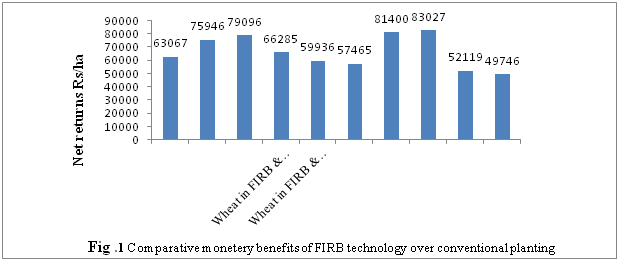 Source: Singh Kuldeep, Gill M S, Singh Avtar, Singh Dalip, Uppal S K and Singh Jayesh 2012. Sugarcane planting in standing wheat using furrow irrigated raised bed (FIRB) method. Sugar Tech 14: 351-56.
Source: Singh Kuldeep, Gill M S, Singh Avtar, Singh Dalip, Uppal S K and Singh Jayesh 2012. Sugarcane planting in standing wheat using furrow irrigated raised bed (FIRB) method. Sugar Tech 14: 351-56.
Estimated benefits of FIRB in Western Uttar Pradesh
Estimated benefits due to FIRB method has been carried out on sugarcane plant crop of prominent wheat–sugarcane system popular in this western part of Uttar Pradesh (Saharpur, Meerut, Muradabad and few part of Bareilly zones) during 2016-17. The total monetary returns due to this technology expected to generate was Rs 900 crore to the growers of these zones. The details worked out as below:
Table 7. Estimated benefits of FIRB in Western Uttar Pradesh
| Items | Units |
| Total area under wheat-sugarcane system | 0.6 m ha |
| Average yield of cane in wheat-sugarcane system | 50 t/ha |
| Enhanced cane yield due to FIRB method | 30% |
| Actual enhancement in yield due to FIRB technology | 5 t/ha |
| Total enhanced yield by FIRB in wheat-sugarcane system | 3 million tonnes |
| Total achievable value due to this technology over conventional Rs. | 900 Crore |
Technological interventions and accomplishments (UP):
Stagnant cane yield and low sugar recovery became the identity of sugar industry in Uttar Pradesh over the years. There was a challenge to break this jinx with large scale adoption of technological interventions. This challenge was accepted and started working with deciding strategic plan encompassing identification of technological interventions, sensitization of stakeholders, deploying scientific manpower with active cooperation and logistic support from cane development department, Govt. of U.P. & sugar mills.
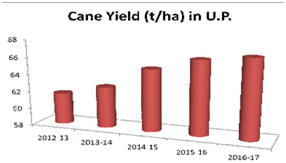
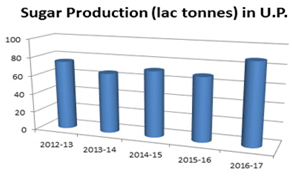
Unavailability of healthy seed material was major impediment in replacement of old cane varieties with newly released varieties. This was addressed with implementation of entrepreneurship development programme in seed cane production in farmers’ fields. Every year 2000 t of breeder seed of new cane varieties was produced and multiplied in nurseries and cane development department of state government of Uttar Pradesh ensured that it reached to the actual field of the farmers. In this way, scarcity of healthy seed material of new cane varieties was mitigated to a great extent. Before year 2012 State cane department was unwilling to recommend varieties tested under AICRP (S) and subsequently released by Central Variety Release Committee (CVRC). This issue was raised before State Government of U.P. and since 2012, CVRC released varieties was also added in the list of variety recommended for cultivation in the State.
This paved the way for large scale adoption of early maturing high sugar variety specially Co 0238 and CoLk 94184 in Uttar Pradesh. Introduction of these varieties changed the sugarcane and sugar production scenario of U.P. Dramatically another breakthrough in planting was achieved by the adoption of Trench method in about 2.0 lac ha leading to cane yield enhancement by 15-20 t/ha. Post-harvest losses remained major concern as it greatly impairs sugar recovery. This problem was addressed with spraying a mixture of sodium metasilicate (0.5%) + benzalkonium chloride (0.2%) solution on cane after harvest. This led to gain in sugar recovery by 0.3 to 0.5 units. The large scale adoption of different variants of sugarcane planters helped farmer to complete planting timely amidst labour scarcity and this also helped gain in yield by 8-10%. Likewise, introduction of ratoon promoter machine enhanced ratoon cane yield by 10-15%. Intercropping of pulses, vegetables, oilseeds and cereals with sugarcane gave ample opportunity to cane growers to earn extra income of Rs.50000 to Rs.200000 per ha.
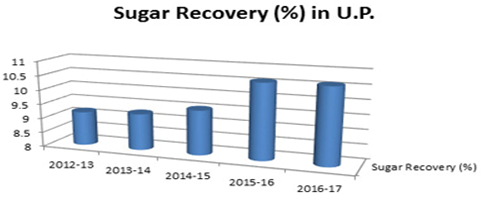
Interface meetings with state cane department and sugar mills were organized regularly to decide operational plan for introduction of these interventions in farmers’ fields over large area. Those plans were implemented with active participation of all the stakeholders.
